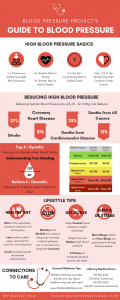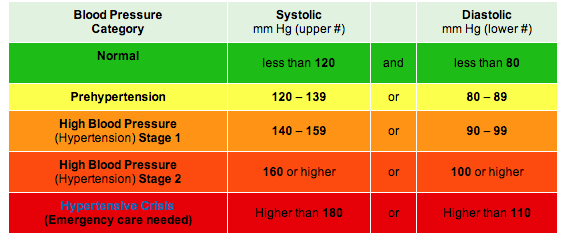What Is Blood Pressure?
(Sources: American Heart Association, National Heart, Blood, and Lung Institute)
Blood pressure is the force of blood pushing against the walls of the arteries. It is determined by how much blood your heart pumps and how much resistance to the flow of blood occurs in your arteries. It is through the arteries that oxygenated blood is transported throughout your body. Blood pressure is high if resistance to blood flow is high – this means that blood is not able to easily be transported throughout your body!
How is blood pressure measured?
(Sources: American Heart Association, National Heart, Blood, and Lung Institute – (1) What Is Blood Pressure? & (2) What Are High Blood Pressure and Prehypertension?)
When blood pressure is measured, two numbers are recorded: one for the systolic blood pressure and one for the diastolic blood pressure.
- The systolic pressure measures the pressure in the arteries when the heart beats (the heart muscle contracts). This is when your blood pressure is highest.
- The diastolic pressure measures the pressure in the arteries between heartbeats (the heart muscle is resting and refilling with blood). This is when your blood pressure is lowest.
Blood pressure is usually expressed as a ratio of systolic to diastolic blood pressure. The units of blood pressure are typically millimeters of mercury (mm Hg).
What Is High Blood Pressure (HBP/Hypertension)?
(Sources: American Heart Association, Centers for Disease Control and Prevention – (1) About High Blood Pressure & (2) High Blood Pressure, Mayo Clinic, National Heart, Blood, and Lung Institute)
High blood pressure, or hypertension, is a condition in which the force of blood flow against the walls of the arteries is strong, meaning the blood is having difficulty going through! This can occur if the amount of blood flow is large or if the walls of the arteries are narrow. Blood pressure usually rises and falls throughout the day, but if it stays elevated for an extended period of time, it can lead to health problems. Situations of isolated systolic high blood pressure are common – the diastolic blood pressure does not need to be high for you to have high blood pressure! The systolic blood pressure usually increases with age (unlike the diastolic pressure, which usually decreases after a certain age). High systolic blood pressure can lead to stroke, heart attack, congestive heart failure, kidney damage, blindness, or other conditions. Though it cannot be cured, it can be treated! A high diastolic blood pressure is correlated with greater risk for heart attacks, strokes, and kidney failure. The diastolic blood pressure decreases after around age 55, so this number is an especially important hypertension number for younger people.

There are two types of high blood pressure or hypertension: primary and secondary.
Primary hypertension is the type for which the cause cannot be identified. It is also known as essential hypertension.
Secondary hypertension is caused by pre-existing or underlying conditions. These include:
- Kidney problems or abnormality
- Adrenal gland tumors
- Structural abnormality of the aorta
- Certain congenital defects in blood vessels
- Certain medications (birth control pills, cold medicines, decongestants, over-the-counter pain relievers, prescription drugs)
- Illegal drugs
HBP: Symptoms and Health Risks
(Sources: American Heart Association, Centers for Disease Control and Prevention, Mayo Clinic)
Hypertension increases the risk for other conditions, specifically heart disease and stroke, two of the leading causes of death in the U.S. Other health conditions for which hypertension is a risk factor or indicator include:
- Aneurysm
- Angina
- Damage to the heart and coronary arteries
- Erectile dysfunction
- Fluid in the lungs
- Heart failure
- Metabolic syndrome
- Peripheral artery disease
- Stroke
- Thickened, narrowed, or turn blood vessels in the eyes (which can lead to blindness)
- Troubles with memory or understanding
- Weakened and narrowed blood vessels in the kidneys
Hypertension is known as the “silent killer” due to there often being a lack of signs and symptoms associated with its onset; many people do not even know they have it until they experience other health issues! Thus, it is important to have blood pressure measured regularly! In the U.S., about 1 in 3 adults (67 million people) have high blood pressure, but only around 47% have the condition under control.
Factors That Affect BP
(Sources: American Heart Association, Mayo Clinic)
- Age
- Alcohol intake
- Chronic conditions
- Diabetes
- High cholesterol
- Kidney disease
- Sleep apnea
- Diet, obesity or overweight
- Too much salt
- Too little potassium
- Too little vitamin D
- Family history, race
- Gender-related risk patterns
- Physical activity
- Stress
- Smoking, secondhand smoke
Low Blood Pressure
(Source: American Heart Association)
Low blood pressure may be due to:
- Prolonged bed rest
- Pregnancy
- Decreases in blood volume
- Certain medications
- Heart or endocrine problems
- Severe infection or allergic reaction
- Neurally mediated hypotension
- Nutritional deficiencies
According to the AHA, low blood pressure is not a reason for concern unless symptoms of low blood pressure are apparent, such as:
- Blurred vision
- Cold, clammy, pale skin
- Dehydration or unusual thirst
- Depression
- Dizziness or lightheadedness
- Fainting (syncope)
- Fatigue
- Lack of concentration
- Nausea
- Rapid, shallow breathing
What Can I Do to Manage My Blood Pressure?
(Sources: American Heart Association, Centers for Disease Control and Prevention, Mayo Clinic, National Heart, Blood, and Lung Institute)
Monitoring blood pressure can be done through regular blood pressure measurements. Additionally, lifestyle modifications can be implemented to prevent or help lower high blood pressure.
Lifestyle Recommendations
- Don’t smoke.
- Eat a healthy diet!
- Eat fruits and vegetables (sources of potassium and fiber) as well as whole grains and low-fat dairy foods.
- Eat foods low in cholesterol and saturated and trans fats.
- Increase potassium intake.
- Reduce sodium intake; limit salt consumption. Also limit added sugars.
- Suggested foods: beans, skinless poultry and lean meats, fish
- Engage in regular physical activity.
- Limit alcohol intake.
- Maintain a healthy weight.
- Manage stress.
